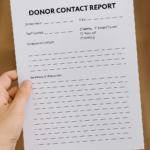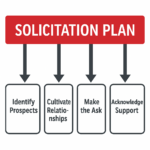Key Components of a Stewardship Report

Once a major gift has been received, the relationship between donor and organisation enters a critical phase: stewardship. One of the most powerful tools a philanthropy officer can use during this phase is the stewardship report—a document that illustrates transparency, demonstrates impact, and reinforces the value of the donor’s contribution. Done right, a stewardship report makes the donor feel informed, valued, and inspired to continue their philanthropic journey with your organisation.
Here are the key components every philanthropy officer should include in a stewardship report for a major gift donor:
1. Personalised Opening and Gratitude
Begin the report with a heartfelt, personalised message that:
- Thanks the donor sincerely for their contribution
- Recaps the purpose and designation of the gift
- Expresses the organisation’s appreciation in human, not transactional, terms
This sets the tone and reinforces the relationship.
Example:
“Thanks to your extraordinary generosity, our Women’s Shelter Program has expanded its reach this year, providing safety and support to over 200 women and children fleeing violence.”
2. Gift Summary and Purpose
Include a clear summary of:
- The amount of the gift
- The date it was received
- Its intended designation (e.g., capital campaign, program support, endowment)
Reaffirming the details gives transparency and demonstrates stewardship integrity.
3. Impact Highlights
This is the heart of the report. Share how the donor’s gift made a difference:
- Quantitative data: KPIs, outputs, reach, financial outcomes
- Qualitative stories: Case studies, beneficiary stories, testimonials
- Milestones achieved: Project launches, new hires, expansions, completions
Avoid vague generalities—offer specific, credible, and meaningful outcomes.
4. Visual Elements
Include charts, photos, and infographics to bring the impact to life:
- Before-and-after images
- Program delivery snapshots
- Infographics showing scale or reach
- Budget breakdown pie charts (if appropriate)
People process visuals faster than text—use them to reinforce your message.
5. Quotes from the Field
Where possible, include direct quotes from:
- Program beneficiaries
- Frontline staff
- Organisational leadership
This gives the report authenticity and connects the donor to real voices impacted by their generosity.
6. Leadership Acknowledgement
Include a message or quote from the CEO, Board Chair, or Head of Programs:
- Reinforcing gratitude
- Sharing vision for what’s next
- Offering to connect directly if the donor has questions
This elevates the importance of the gift and affirms its role in the broader mission.
7. Future Outlook or Next Steps
Provide a look ahead:
- Upcoming plans for the funded program
- New initiatives launching as a result of their support
- Opportunities for continued involvement (advisory groups, events, volunteer roles)
This transitions the donor from being a one-time supporter to a long-term partner.
8. Recognition Summary (If Applicable)
Briefly confirm how the donor has been or will be recognised:
- Public acknowledgements
- Naming rights
- Inclusion in honour rolls or donor walls
If the donor requested anonymity, confirm that this has been respected.
9. Call to Continue the Conversation
End the report by extending an invitation:
- To meet with the program lead
- To tour a site or attend a donor event
- To provide feedback or ask questions
This keeps the engagement active and builds momentum for future giving.
10. Professional Presentation and Timely Delivery
Finally, ensure the report:
- Is branded professionally with your logo and colours
- Is concise—ideally 2–4 pages or a short slide deck
- Is delivered within 6–12 months of the gift (or more frequently for multi-year gifts)
- Is recorded in your CRM with follow-up scheduled
Avoid delays—timely stewardship reinforces trust and professionalism.
A stewardship report is more than a thank-you—it’s a demonstration of impact, a gesture of accountability, and a step toward deeper partnership. For philanthropy officers, it’s one of the most tangible ways to retain major donors, show respect for their generosity, and invite future investment.









